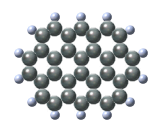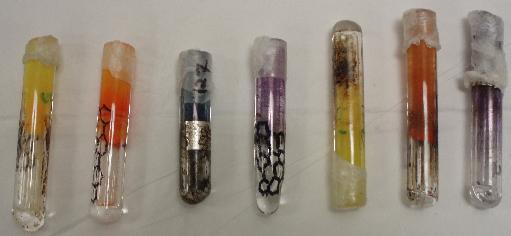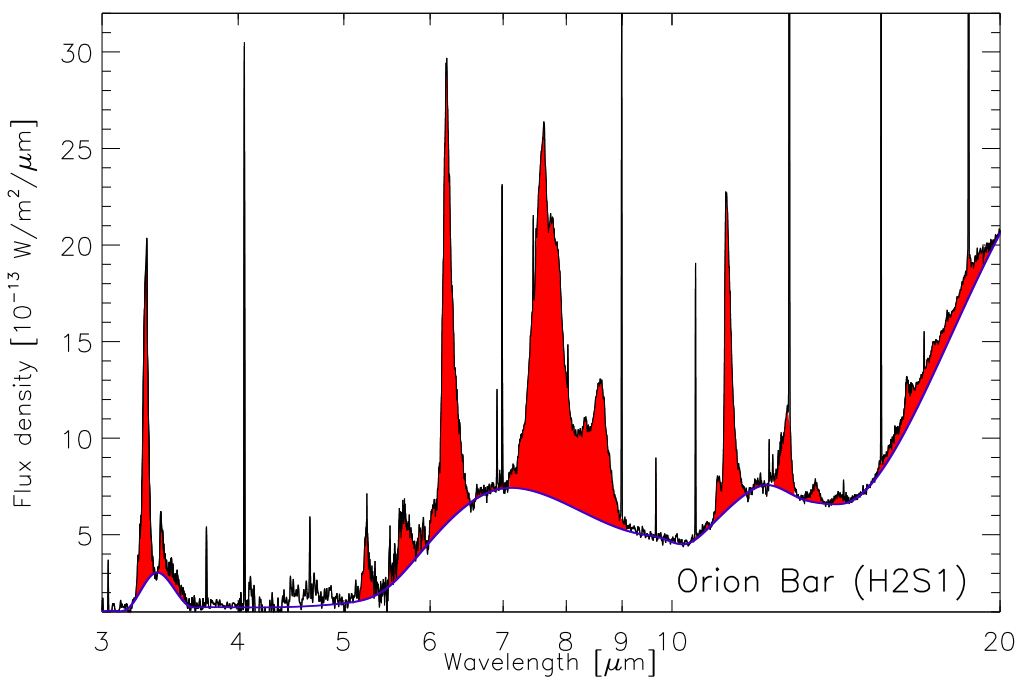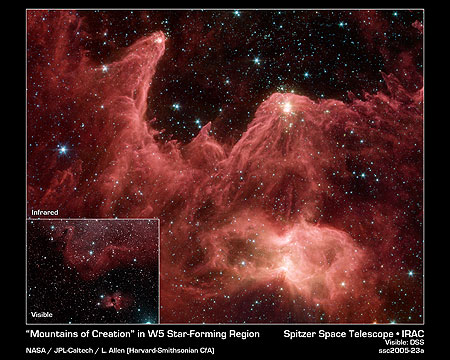Research
Areas of Research:
- Polycyclic Aromatic Hydrocarbons (PAHs), fullerenes and dust
- Interstellar and circumstellar medium
- Galactic and extragalactic star formation
Polycyclic Aromatic Hydrocarbons

A PAH molecule.
Polycyclic Aromatic Hydrocarbons (PAHs) are complex organic molecules made of carbon and hydrogen. They are planar, with each carbon atom bound to 5 other carbon atoms in hexagons (as in chicken-wire), while hydrogen is found at the edge of the molecule.

PAHs are colorful.
PAHs are known on Earth as components of tarry materials naturally present in, for example, coal and crude oil. PAHs are formed in the combustion of carbonaceous fuels and hence are found in auto exhaust, cigarette smoke, candle soot, and (for the less qualified cooks) in burned hamburgers. Nevertheless, some PAHs are quite colorful. PAHs are regularly placed in the media spotlight for their persistence in the environment and their detrimental carcinogenic properties. Due to their long-term stability, they are particularly important pollutants.
Remarkably, the same properties that make PAHs bio-active make them likely players in the prebiotic evolution of life. Although they are not found in living cells as such, slightly modified PAHs are. Over the past three decades, PAHs had been discovered from astronomical objects throughout our Galaxy, the Milky Way, and other galaxies across the universe. This discovery came as quite a surprise since PAHs are shockingly large and complex by interstellar standards. Thus they can provide the carbon reservoir necessary for the formation of life. Under simulated interstellar condition and ultraviolet light, they can react with water and oxygen to produce complex organic molecules that are building blocks of biological molecules. For example, they can be transformed into quinones, molecules that play an essential role in photosynthesis.
To date, PAHs are the largest and most complex molecules known in space. Intimately interwoven with dust, they are formed in the outflows of evolved or dying stars through a mechanism similar to a combustion process. As with people, who can be uniquely identified by their fingerprints, dust and molecules have their own unique set of spectroscopic fingerprints. These are found at infrared wavelengths and hence, this is where we find the signature of these organic molecules. Indeed, the infrared spectra of a wide variety of objects are dominated by emission features, the so-called unidentified infrared (UIR) bands, that we now know are from PAHs in space.

An infrared spectrum from the star-forming region Orion. The PAH bands are in red.
Glowing PAHs.
This infrared emission is pumped by the absorption of stellar UV photons. Once they are electronically excited by the UV, PAHs relax to the groundstate mainly by emitting infrared light that comes from their C-C and C-H vibrations. In this way, the PAH molecules leave their signature across the sky in the form of the UIR bands.
These PAH bands are now found in almost all environments including the interstellar medium, the edges of molecular clouds, reflection nebulae, star-forming regions, evolved stars, and galaxies. Moreover, a remarkable 20-30% of the Galactic infrared radiation is emitted in these PAH bands.

Infrared emission from a star-forming region. The red color traces the infrared emission from PAHs.
Observations from ground-based telescopes and spacecrafts have shown that PAHs are very common and very abundant throughout most of the universe and it is now recognized that PAHs play a crucial role in several astrophysical and astrochemical processes. They are the building blocks in the formation of carbon particles. PAHs dominate the heating and cooling, and hence the temperature, of the interstellar medium via photoelectron ejection, infrared emission and gas-grain collisional cooling. In addition, they influence the charge balance and in this way - through their influence on the equilibrium state of chemical reactions - gas-phase abundances in interstellar clouds. Due to their large surface, they affect surface chemistry and so play a significant role in interstellar chemistry.
In addition, PAHs efficiently convert UV radiation from young massive stars into their bright infrared emission bands. Therefore, their userfulnes as a tracer, i.e., quantitative indicator, of star formation is currently explored, potentially allowing the determination of star formation rates for a large number of galaxies. The global star formation history of the Universe is one of the key indicators for understanding the evolution of galaxies as a whole, and for discriminating among different formation scenarios.
Hence, studying these large and abundant organic molecules, their formation and evolution, and the astrobiological processes that control their abundance is of tremendous importance for our understanding of the universe we inhabit and our cosmic roots.
Although the presence of PAHs in space is now generally accepted, specifics of the emitting population remain elusive. Indeed, identification of the individual PAH molecules is hampered by the fact that the main signature of PAHs, their infrared emission bands, are mostly governed by chemical bonds that are present in all PAH molecules and only have a weaker dependence on specific size and structure. Progress is being made however and strong constraints are placed on molecular structures, sizes, heteroatom substitution, charge and related properties. Similarly, although it is firmly established that the PAH emission bands vary from object to object and spatially within objects, the origin of these variations is currently not entirely understood.
Hence, it is clear that the ultimate goals - the full understanding of PAHs, their formation and evolution and the full exploitation of PAHs as a diagnostic tool to unravel the secrets of the universe - is yet to be reached. It is crucial in this quest to obtain insight in all the environments where the PAH bands occur and in the behaviour of PAHs relative to that of other diagnostics. Indeed, the use of PAHs as a diagnostic tool is tightly coupled with our understanding of their characteristics and their interaction with the environment.
Fortunately, the future is bright. Current and future highly sensitive infrared instruments provide a unique tool for studying PAHs within the Milky Way and for studying PAHs and star formation at small and large distances and scales, ranging from regions of massive star formation in our Galaxy to star formation in the early universe.
Interesting links:


